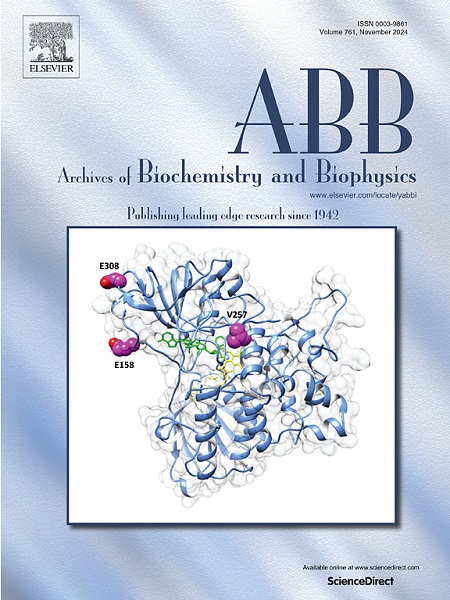In silico based re-engineering of a computationally designed biosensor with altered signalling mode and improved dynamic range
IF 3.8
3区 生物学
Q2 BIOCHEMISTRY & MOLECULAR BIOLOGY
引用次数: 0
Abstract
A current challenge in the rational design of biomolecular sensors is the ability to custom design binding affinities and detection mode in silico. To this end, we re-engineered a previously reported computationally-designed fluorescent maltooligosaccharide (MOS)-detecting biosensor to both alter its ligand-binding affinity and to analyse the underlying sensing mechanism. The dynamic range of the biosensor was expanded through the computer aided introduction of a series of amino acid substitutions in the starting protein scaffold (MalX from Streptococcus pneumoniae), which generated a biosensor set with binding affinities spanning over five orders of magnitude. The impact of the introduced substitutions on the underlying mode of signal generation was assessed in silico using our previously reported Computational Identification of Non-disruptive Conjugation sites (CINC) pipeline. CINC utilizes molecular dynamics simulations and an in-house developed algorithm to examine and exploit the structural dynamics of a protein at amino acid-level resolution. Using CINC, we demonstrate that re-engineering of the MOS-detecting biosensor set resulted in sensors with two distinct output modes which differed based on local conformational changes at the fluorescently modified reporter position. These output modes were classified as “ligand-sensing”-type biosensors (readout based on the tool sensing a unique conformation in the ligand-bound state), and “apo-sensing”-type biosensors (readout based on the tool sensing a unique conformation in the apo state). Together, these results demonstrate that structural dynamics at the individual amino acid residue level can be used as an engineer-able feature to rationally alter the fluorescence reporting properties of a biosensing device. Moving forward, the CINC workflow can also be adapted for the rational design of protein dynamic properties maximizing its utility as an in silico design platform for custom biomolecular tools.

一种改变信号模式和改进动态范围的计算设计生物传感器的硅基再造。
目前合理设计生物分子传感器的一个挑战是能够在硅上定制设计结合亲和力和检测模式。为此,我们重新设计了先前报道的计算设计的荧光寡糖(MOS)检测生物传感器,以改变其配体结合亲和力并分析其潜在的传感机制。生物传感器的动态范围通过计算机辅助引入一系列氨基酸取代的起始蛋白支架(来自肺炎链球菌的MalX)而扩大,这产生了一个结合亲和力超过五个数量级的生物传感器集。采用我们之前报道的非破坏性共轭位点(CINC)管道的计算识别,在计算机上评估了引入的替换对信号产生的潜在模式的影响。CINC利用分子动力学模拟和内部开发的算法来检查和利用氨基酸水平分辨率的蛋白质结构动力学。使用CINC,我们证明了mos检测生物传感器组的重新设计导致传感器具有两种不同的输出模式,这些模式基于荧光修饰的报告位置的局部构象变化而不同。这些输出模式被分类为“配体感应”型生物传感器(基于工具感应配体结合状态下的独特构象的读出)和“载子感应”型生物传感器(基于工具感应载子状态下的独特构象的读出)。总之,这些结果表明,在单个氨基酸残基水平上的结构动力学可以作为一个可工程的特征来合理地改变生物传感装置的荧光报告特性。展望未来,CINC工作流程也可以适应蛋白质动态特性的合理设计,最大限度地发挥其作为定制生物分子工具的硅设计平台的效用。
本文章由计算机程序翻译,如有差异,请以英文原文为准。
求助全文
约1分钟内获得全文
求助全文
来源期刊

Archives of biochemistry and biophysics
生物-生化与分子生物学
CiteScore
7.40
自引率
0.00%
发文量
245
审稿时长
26 days
期刊介绍:
Archives of Biochemistry and Biophysics publishes quality original articles and reviews in the developing areas of biochemistry and biophysics.
Research Areas Include:
• Enzyme and protein structure, function, regulation. Folding, turnover, and post-translational processing
• Biological oxidations, free radical reactions, redox signaling, oxygenases, P450 reactions
• Signal transduction, receptors, membrane transport, intracellular signals. Cellular and integrated metabolism.
 求助内容:
求助内容: 应助结果提醒方式:
应助结果提醒方式:


